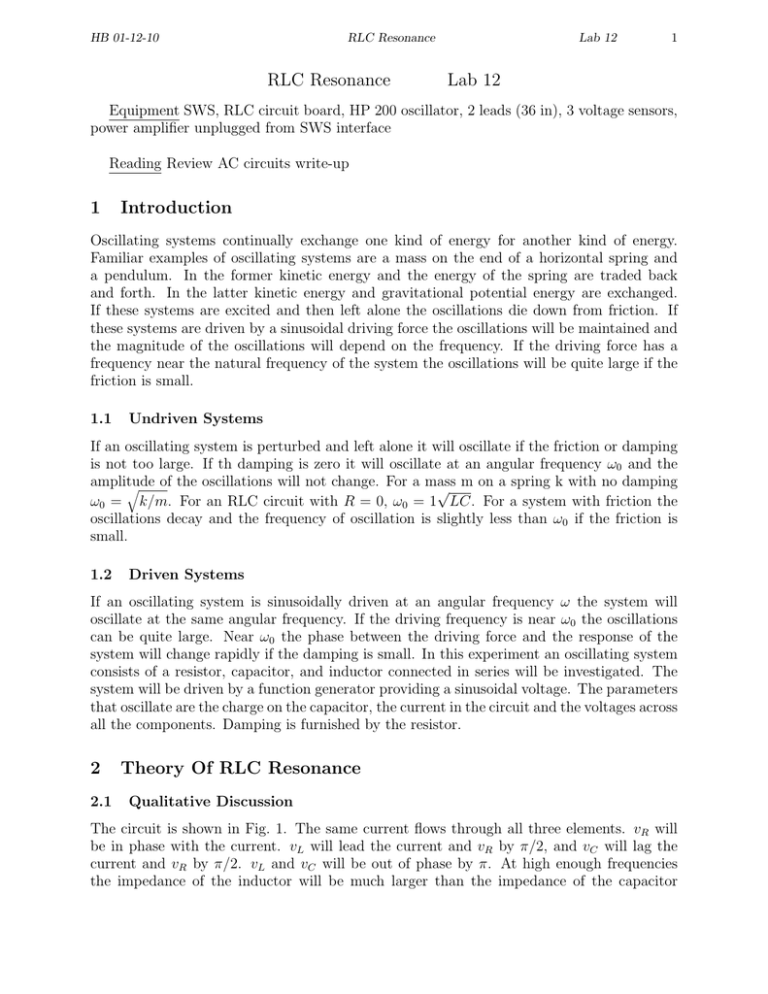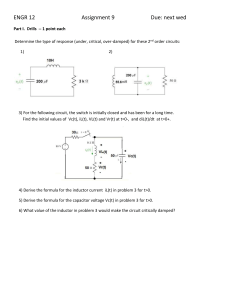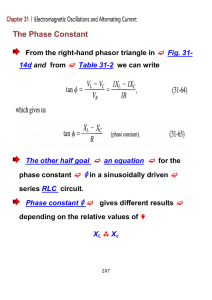RLC Resonance Lab 12
advertisement

HB 01-12-10 RLC Resonance RLC Resonance Lab 12 1 Lab 12 Equipment SWS, RLC circuit board, HP 200 oscillator, 2 leads (36 in), 3 voltage sensors, power amplifier unplugged from SWS interface Reading Review AC circuits write-up 1 Introduction Oscillating systems continually exchange one kind of energy for another kind of energy. Familiar examples of oscillating systems are a mass on the end of a horizontal spring and a pendulum. In the former kinetic energy and the energy of the spring are traded back and forth. In the latter kinetic energy and gravitational potential energy are exchanged. If these systems are excited and then left alone the oscillations die down from friction. If these systems are driven by a sinusoidal driving force the oscillations will be maintained and the magnitude of the oscillations will depend on the frequency. If the driving force has a frequency near the natural frequency of the system the oscillations will be quite large if the friction is small. 1.1 Undriven Systems If an oscillating system is perturbed and left alone it will oscillate if the friction or damping is not too large. If th damping is zero it will oscillate at an angular frequency ω0 and the amplitude of the oscillations will not change. For a mass m on a spring k with no damping q √ ω0 = k/m. For an RLC circuit with R = 0, ω0 = 1 LC. For a system with friction the oscillations decay and the frequency of oscillation is slightly less than ω0 if the friction is small. 1.2 Driven Systems If an oscillating system is sinusoidally driven at an angular frequency ω the system will oscillate at the same angular frequency. If the driving frequency is near ω0 the oscillations can be quite large. Near ω0 the phase between the driving force and the response of the system will change rapidly if the damping is small. In this experiment an oscillating system consists of a resistor, capacitor, and inductor connected in series will be investigated. The system will be driven by a function generator providing a sinusoidal voltage. The parameters that oscillate are the charge on the capacitor, the current in the circuit and the voltages across all the components. Damping is furnished by the resistor. 2 2.1 Theory Of RLC Resonance Qualitative Discussion The circuit is shown in Fig. 1. The same current flows through all three elements. vR will be in phase with the current. vL will lead the current and vR by π/2, and vC will lag the current and vR by π/2. vL and vC will be out of phase by π. At high enough frequencies the impedance of the inductor will be much larger than the impedance of the capacitor HB 01-12-10 RLC Resonance Lab 12 2 or the impedance of the resistor. The current will be small. At low enough frequencies the impedance of the capacitor will be much larger than the impedance of the inductor or the impedance of the resistor. The current will be small. At the resonant frequency the reactances of the capacitor and inductor are equal and their impedances cancel out. The current is a maximum. At resonance the sum of the voltages across the inductor and capacitor is zero, but vC and vL can be quite large if R is small. 2.2 Quantitative Discussion The total impedance Z of the RLC combination is XL − XC . R (1) Let the voltage applied to the circuit be v(t) = V cos(ωt). Then the phasor voltage V̄ = V . The phasor current I¯ will be h i1 1 2 2 jθ 2 = R + (XL − XC ) e , Z = ZR + ZL + ZC = R + jωL + jωC V̄ I¯ = =h Z V e−jθ R2 + (XL − XC ) 2 arctan θ = (2) i1 2 The phasor voltage across the resistor V̄R is RV e−jθ ¯ R=h V̄R = IZ i1 R2 + (XL − XC )2 2 (3) The phasor voltage across the inductor V̄L is π j(−θ+ 2 ) ¯ L = h V XL e V̄L = IZ i1 R2 + (XL − XC )2 2 (4) The phasor voltage across the capacitor V̄C is π ¯ C=h V̄C = IZ V XC ej(−θ− 2 ) R2 + (XL − XC )2 i1 (5) 2 From these equations the following conclusions can be drawn. 1. The current is a maximum when XL = √ XC . This occurs at the resonant frequency ω0 which is given by f0 = 2π , where ω0 = 1/ LC. 2. At resonance the magnitude of the voltage across the capacitor is equal to the magnitude of the voltage across the inductor. 3. At resonance the magnitude of the voltage across the capacitor and the magnitude of the voltage across the inductor are equal to Q times the source voltage, where Q = (ω0 L)/R. Q is the “quality factor” of the circuit. Q is large if R is small. 4. The larger Q is the narrower the resonance. HB 01-12-10 RLC Resonance Lab 12 3 5. The phase difference between the capacitor voltage and the inductor voltage is always π. 6. For f f0 the current is small and determined by XL . 7. For f f0 the current is small and determined by XC . 3 The Q or Quality Factor Generally, the less the friction in an oscillating system, the better the system is judged to be. A dimensionless parameter named Q (for quality factor) is defined. The larger the Q the less the resistance and the better the system. For the series RLC circuit, Q = ω0 L/R, which is the inductive reactance at resonance divided by the resistance. The Q of an oscillating system can be defined as Q = 2π 3.1 the energy stored in the circuit the energy lost per cycle (6) Q and the Undriven Series RLC Circuit If R is low enough and the series RLC circuit is excited and the left alone, the current will oscillate and decay exponentially as exp(−ω0 t/2Q). If R is large enough the current will not oscillate but decay monotonically. The circuit is said to be overdamped. Critical damping separates these two behaviors and is given by the resistance RC = 2ω0 L or Q = 1/2. The damping of meters is often adjusted to be critical. 3.2 Q and the Driven Series RLC circuit If the series RLC circuit is driven by a constant amplitude sinusoidal voltage source the current as a function of frequency will exhibit resonant behavior with the maximum current at a frequency ω0 = 2πf0 . See Fig. 2. The width of the resonance √ curve decreases as Q increases. If Q 1 the half power points, where the current is 1/ 2 of the maximum value, occur at the two frequencies f0 = ±f0 /2Q. The “bandwidth” B of of the circuit f0 /Q. At the half power points the current and voltage are ±45 degrees out of phase. In this experiment the Q is not nearly high enough to use these approximations. 4 Experiment The experiment will use the 10 ohm resistor, the 8.2 mH inductor (no iron) and the 100 µF capacitor on the circuit board. Calculate ω0 . Calculate Q. The R you use in calculating Q should include the resistance of the inductor. Because the inductor has some resistance, the voltage across the inductor, both magnitude and phase, will no completely agree with the calculations presented. This will become more evident as the applied frequency is made lower. You should look for this and discuss this. Use the Fluke multimeter to measure the ohmic resistance of the coil (inductor). Then hook up the circuit as shown in Fig. 3, connected the 3 voltage sensors across R, L, C. The Fluke should be connected across all three elements so as to measure the AC voltage of the function generator. HB 01-12-10 RLC Resonance Lab 12 4 The voltage amplitude of the function generator will not be constant as the frequency is changed. This not because the function is lousy. In fact it is a rather nice one. The function generator has a 50 Ω internal impedance so as to ”‘match”’ properly to a 50 |Omega coaxial cable. The various waveforms produced by the source will travel from the 50 Ω cable undistorted. Unfortunately for this experiment the impedance of the RLC circuit changed with frequency and so will the voltage across the circuit. At a given frequency the various phase relationships between the components will be properly displayed and the relative magnitude of the voltage will also be properly displayed. But the relative magnitudes of the voltages for two different frequencies will not be correct unless the voltage across the RLC circuit is adjusted to be the same for the two frequencies. That being said, adjust the output of the function generator to some reasonable value like 2 V at resonance and then sweep the frequency from well below the resonant frequency to well above the resonant frequency. Do this slowly several times. On the scope, carefully scrutinize the relative magnitudes and phases of the voltages across the R, L, and C for the various frequencies and discuss what you see Now do a more careful investigation by choosing a set of discrete frequencies separated by about 20 Hz (exact value up to you). These frequencies should start well below resonance and end well above resonance. At each frequency adjust the voltage output of the function generator, as measured by the multimeter, to the same value. At each frequency measure the amplitudes of the voltages vR , vL , and vC . Also measure the phases of vL and vC with respect to vR . Plot the magnitude of the current versus the frequency and determine the frequency at which the maximum current occurs. Does this agree with you calculation of ω0 = 2πf0 . Plot the magnitude and phases of vL and vC versus frequency. Discuss your results. Insert the iron rod into the inductor and determine the resonant frequency. What is the value of the inductance with the iron rod inserted? 5 Question This experiment has been concerned with the series RLC circuit driven by a sinusoidal voltage source. Qualitatively discuss the parallel RLC circuit driven by a sinusoidal current source. At resonance is the voltage maximum or minimum. At frequencies way above and below resonance is the voltage high or low? 6 Finishing Up Please leave the bench as you found it. Thank you. HB 01-12-10 RLC Resonance Figure 1: RLC series circuit Figure 2: Current as a function of frequency Figure 3: Component connections Lab 12 5


